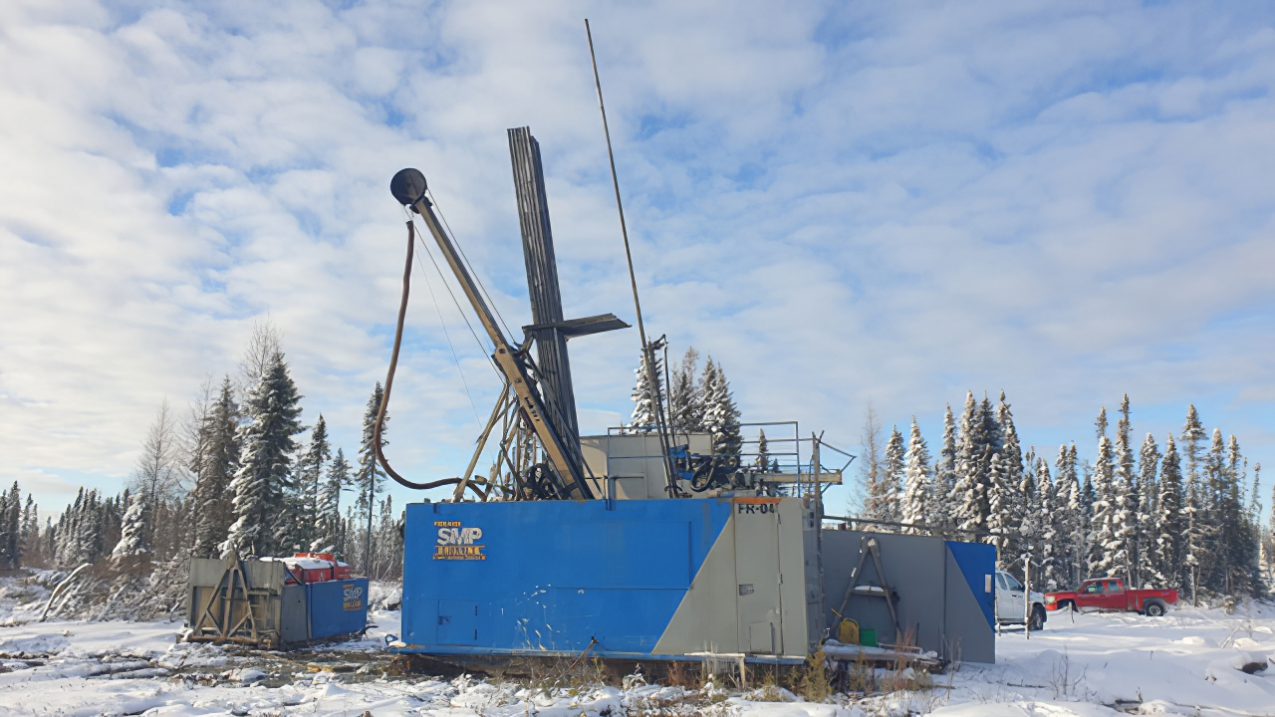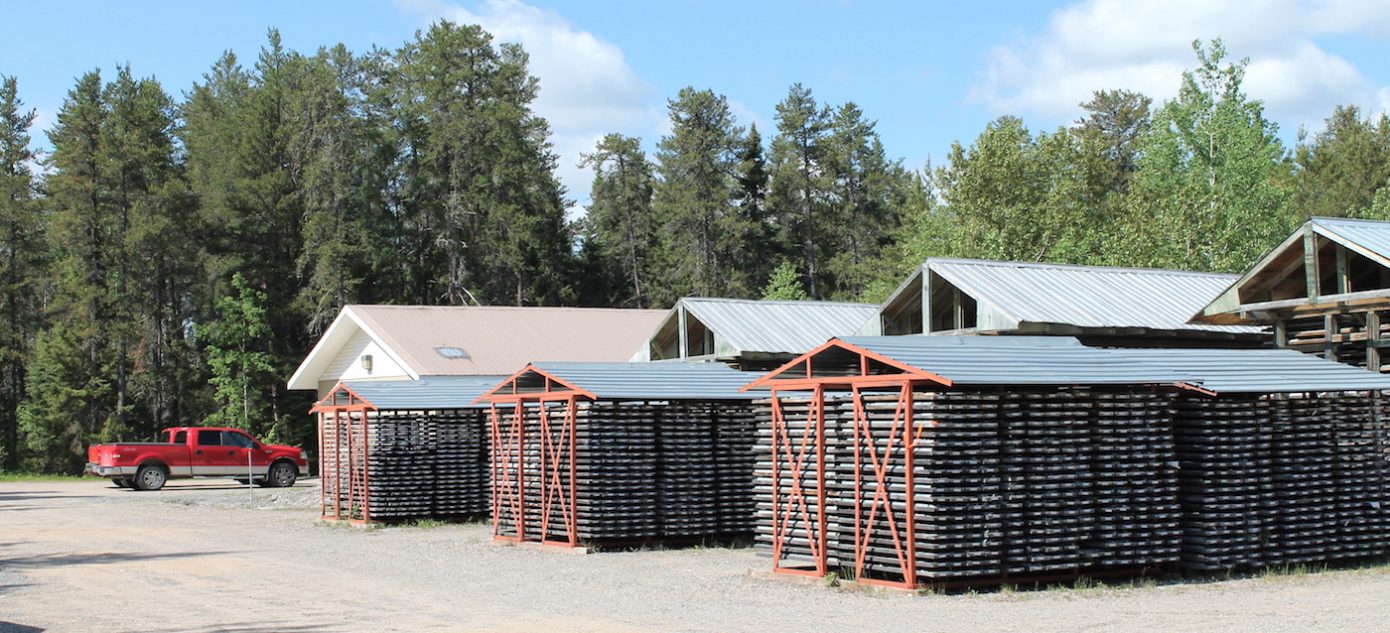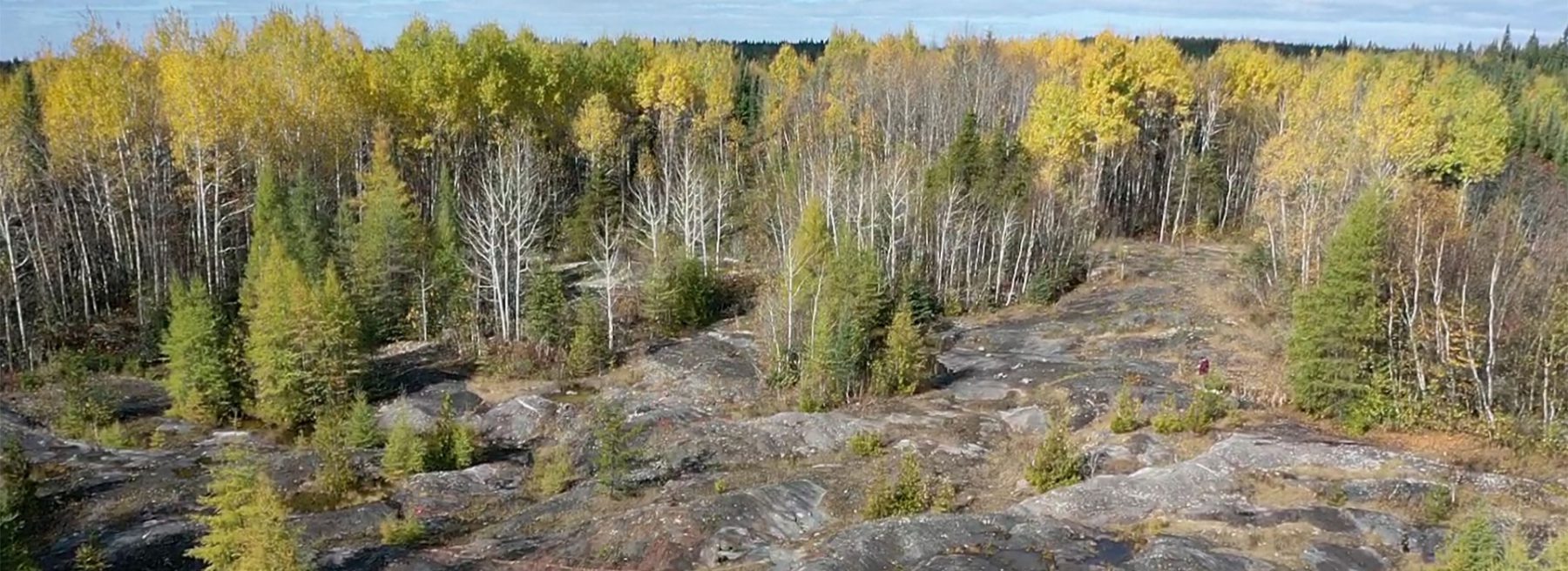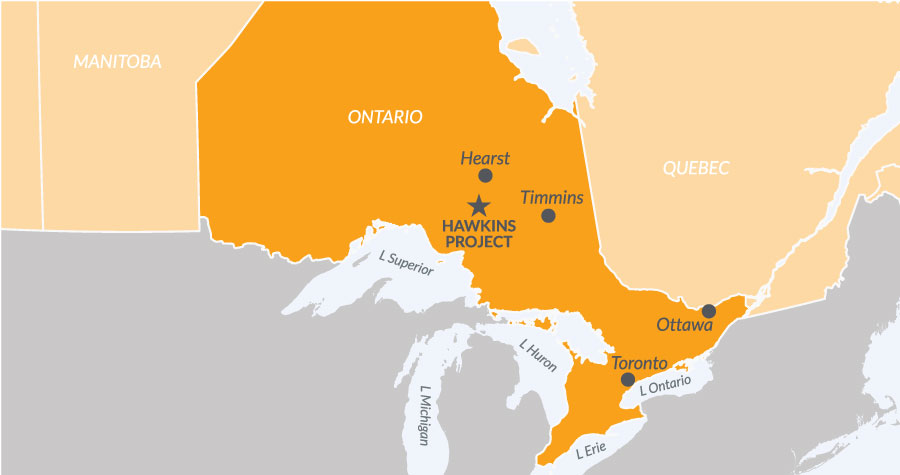Ontario features a widespread array of valuable minerals

By Ellsworth Dickson
Ontario has an illustrious history of mineral discoveries and mining. In the early years of the 20th century, huge veins of silver were discovered by workers on the Temiskaming and Northern Ontario Railway that triggered the Cobalt silver rush that was followed by the Timmins region gold discoveries. In total, the Cobalt area mines produced 460 million ounces of silver.
The prolific Abitibi Gold Belt that we featured in our Quebec coverage extends westward across the border into northeast Ontario and includes the Timmins area where the Dome, Hollinger and McIntyre mines launched the Canadian mining industry. These three mines became three of the largest gold mines ever found in North America with 47 million ounces of gold produced having a total value of US$59 billion in today’s dollars. The Dome mine was in production for 107 years.
The Abitibi Gold Belt incudes the Kirkland Lake region where exploration programs are currently underway. Kirkland Lake Gold has seen great success at it producing Detour Lake Mine and Macassa Mine Complex – a $53 stock.
Then there are the massive nickel discoveries at Sudbury that began in 1883. The total ore mined to date in Sudbury is approximately 1.7 billion tonnes with 40 billion pounds of nickel, 36 billion pounds of copper, 70 million ounces of platinum, palladium and gold and 283 million ounces of silver recovered. Historic production and known reserves in the Sudbury Basin have a total value of about a trillion dollars.
There are scattered gold deposits in northwestern Ontario, including the famous Hemlo gold deposit which is Canada’s third largest lode gold deposit. Barrick Gold’s Hemlo Mine has produced more than 21 million ounces of gold, and has been operating continuously for more than 30 years. It consists of the Williams mine-an underground and open pit operation-located about 350 km east of Thunder Bay, Ontario.
Another interesting development is what is known as the ‘Ring of Fire’ in northwestern Ontario. Noront Resources has the largest land position in the Ring of Fire, an emerging multi-metals area located in the James Bay Lowlands. As a result of the 2015 acquisition of the Cliffs chromite properties and the 2016 acquisition of MacDonald Mines, Noront now has ownership or a controlling interest in all the major discoveries to date in the region. The company’s first project is a 100%-owned, high-grade, nickel, copper and platinum group element (PGE) deposit called Eagle’s Nest.
Today, Ontario is the largest producer in Canada of gold, platinum group metals and nickel, and the second largest producer of copper. The value of mineral production in Ontario was $10.7 billion in 2019 with 90% of the mining GDP staying in Ontario.
There are 40 mine sites operating in Ontario targeting nickel, gold, copper, zinc and platinum group metals as well as industrial minerals such as salt, gypsum, talc, calcium carbonate, nepheline syenite and other industrial minerals.
Ontario remains an attractive jurisdiction with $497 million invested in mineral exploration and deposit appraisal in 2019.
Moneta Porcupine Mines Inc. recently acquired the O3 Mining Garrison Project adjacent to its Golden Highway Project 100 km east of Timmins. Now named the Tower Gold Project, the two combined projects host an indicated resource of 4.0 million ounces.
Recently listed Lasalle Exploration is focusing on early stage projects in Ontario and Quebec. The company is drilling its Blakelock Gold Project in northeast Ontario 50 km due south of Kirkland Lake Gold’s Detour mine.
Another newly listed company, E2 Gold Inc., is drilling its flagship Hawkins Gold Project in north-central Ontario with the objective of expanding the NI 43-101 compliant McKinnon Inferred Resource of 6.2 million tonnes grading 1.65 g/t gold.
According to the Ontario Mining Association, with Toronto being the mining finance capital of the world, the Toronto Stock Exchange (TSX) and Toronto Venture Exchange (TSX-V) list more mining companies than any other exchange (approx. 1,100 in 2019). These two exchanges are home to more than half of the public mining companies in the world. In 2019, the TSX and the Venture Exchange raised $12.5 billion in new equity capital for mining.
Clearly, Ontario still has great exploration potential and an important source of new wealth for the province and Canada.
 Moneta Porcupine Mines Inc. [ME-TSX; MPUCF-OTC; MOP-XETRA] is a company that aims to uncover the exploration potential of the Timmins, Ontario gold mining camp, an area that has produced well over 85 million ounces of gold to date.
Moneta Porcupine Mines Inc. [ME-TSX; MPUCF-OTC; MOP-XETRA] is a company that aims to uncover the exploration potential of the Timmins, Ontario gold mining camp, an area that has produced well over 85 million ounces of gold to date.
The company added substantial value to shareholders by pursuing the acquisition of the O3 Mining Garrison Project which occurs adjacent to Moneta’s Golden Highway Project located 100 km east of Timmins. The 200 km2 Tower Gold Project, a combination of the former Golden Highway and Garrison Projects, hosts a NI 43-101-compliant indicated resource of 4.0 million ounces (122 million tonnes at 1.01 g/t gold) as well as an inferred resource of 4.4 million ounces (95 million tonnes at 1.44 g/t gold in both bulk tonnage underground and open pit deposits.
Moneta Porcupine signed a definitive share purchase agreement with O3 Mining Inc. in January 2021 [OIII-TSXV] whereby Moneta will acquire all of the issued and outstanding shares of Northern Gold Mining Inc., a wholly owned subsidiary of O3 Mining, which owns 100% of the Golden Bear assets, including the Garrison Gold Project. Concurrent with the transaction, which has received shareholder approval, Moneta raised C$22.6 million in a bought deal equity financing.
Moneta will issue O3 Mining approximately 150 million shares and O3 Mining will own 30% of Moneta pre-financing. The acquisition is expected to close at the end of February, 2021.
The combination of the Golden Highway and Garrison properties will result in 4.0 million ounces of gold in the indicated category and 4.4 million ounces in the inferred category and inventory expansion opportunities on the combined landholdings one of the largest in the area. The project is within trucking distance of six existing mills each of which could potentially offer toll milling services to a future mining operation. The acquisition of the O3 Mining assets in Timmins creates one of the largest undeveloped gold projects in North America.
Plans call for the rapid expansion of resources. The current drill program is for 70,000 metres to focus on the successful program from 2020 and drill new targets and expand current resources.
Part of this drilling program is to expand open pit resources at South West to connect with the Windjammer South open pit. In addition, Moneta will test the expansion potential of the Westaway underground deposit, newly discovered in 2020 and drilled to identify 662,000 ounces of gold.
Drilling the Discovery extensions to the west will be part of the program as well as additional drilling on resource extensions at the Garrison deposit and drilling the new targets – the Twin Creeks Zone and South Basin. Infill drilling at the 55 zone and Windjammer South pits will also be conducted to increase ounces and reduce the strip ratio. In addition to the expansion of the starter pit at Garcon, Moneta will target new high grade areas at Buffonta and Gold Pike.
The drilling will lead to updated resource estimates in Q3 2021 and an updated PEA on the larger combined project which is expected to show significant growth in scope, production profile, valuation and cost savings through development synergies on the combined Golden Highway and Garrison projects. Other plans call for metallurgical test work, optimization of the flow sheet and commencement of pre-feasibility studies on the combined project in 2022.
Based on the results of drilling completed in Q2 2020 on the Westaway/West Block deposit, the company has developed a new maiden underground resource of 661,900 ounces grading 4.71 g/t gold at the new Westaway/West Block discovery using a 3.00 g/t cut-off.
The company released a preliminary economic assessment (PEA) for the South West deposit only at Golden Highway in September 2020 which is estimated to contain an indicated resource of 592,000 ounces of gold grading 4.07 g/t plus an inferred resource of 1.24 million ounces of grade 4.01 g/t at a 2.6 g/t Au cut-off.
The South West underground gold deposit, one of 6 deposits located on the Golden Highway project, highlighted an underground bulk mining operation consisting of an 11-year mine life with an after-tax NPV5% of C$236MM, IRR of 30% and a 3.4 year payback, generating C$371MM LOM after-tax free cash flow. The project envisaged producing 76,000 oz/pa at a cash cost of US$590/oz at a gold price of US$1,500/oz and an exchange rate of US$0.77/C$. The open pit resources and new underground discoveries have not yet been subjected to a preliminary economic assessment study at Golden Highway.
The PEA only assessed the economics of producing gold from the South West deposit as an underground mine. The combined project including the Garrison Gold PEA results in production estimates of 200,000 ounces of gold per year at cash costs of approximately US$700/ounce. Of course, that production level is expected to increase substantially as it did not include the large open pit operation and multiple underground operations that the company now visualizes.
A PEA study on the Garrison Gold project completed in December 2020 also highlighted robust economics. The study highlighted a measured and indicated open pit resource of 1,822,000 ounces contained within 66.3 Mt @ 0.86 g/t Au and an inferred open pit resource of 1,062,000 ounces contained within 45.3 Mt @ 0.73 g/t Au at a 0.30 g/t Au cut-off. The PEA study showed an open pit mining operation consisting of a 12-year mine life with an after-tax NPV5% of C$321MM, IRR of 33% and a 2.3 year payback. The project envisaged open pit mining producing 121,000 oz/pa in years 1 to 8 (94,000 oz/pa LOM), at a strip ratio of 2.7:1 at a cash cost of US$721/oz using a gold price of US$1,450/oz and an exchange rate of US$0.75/C$.
Moneta has a portfolio that includes 100% interests in other gold projects (Tower, Denton, Kayorum, Ogden, Nighthawk Lake and North Tisdale) and a 50% interest in a joint venture with Kirkland Lake Gold Ltd. [TSX, NYSE-KL; ASX-KLA]. All are located along the famous Destor-Porcupine Fault Zone corridor, a key mineralized structure in the fabled Abitibi Greenstone belt.
Moneta is led by CEO Gary O’Connor, who is also the company’s chief geologist. A former District Manager (1990-2000) with Freeport-McMoran Inc. [NYSE-FCX] in Indonesia, he distinguished himself by helping to uncover the major fraud committed by Bre-X Minerals with its alleged Busang “gold deposit” in Indonesia.
The company is supported by various institutional shareholders, including Scotia (1832), Dundee, Eric Sprott, RBC, Mackenzie and US Global. Moneta Porcupine will have 553,855,603 shares outstanding post-transaction and $26 million in its treasury.
 LaSalle Exploration Corp. [LSX-TSXV] completed its initial public offering in January 2020 with intent to focus on early-stage exploration projects in Ontario and Quebec capitalizing on the Board and Managements track record of exploration success. “Experience open to new tricks in areas we know are underexplored and deposits are still to be found” is how LaSalle President and CEO Ian Campbell described a strategy he believes offers the most upside for potential investors.
LaSalle Exploration Corp. [LSX-TSXV] completed its initial public offering in January 2020 with intent to focus on early-stage exploration projects in Ontario and Quebec capitalizing on the Board and Managements track record of exploration success. “Experience open to new tricks in areas we know are underexplored and deposits are still to be found” is how LaSalle President and CEO Ian Campbell described a strategy he believes offers the most upside for potential investors.
Campbell, an experienced geologist, was CEO of Temex Resources Corp. when it was acquired by Lake Shore Gold in 2015. LaSalle founder and Chairman Dan Innes occupied similar roles at Lake Shore when the West Timmins and Thunder Creek gold mines were discovered and the Bell Creek Mine was purchased at Timmins, Ontario. Lake Shore itself was taken over in 2016 by Tahoe and subsequently by silver mining giant Pan American Silver Corp. in 2018.
With $2.5 million in the treasury, LaSalle is aiming to repeat those successes in under-explored districts of the Abitibi, an area globally recognized for mining investment based on mineral potential, jurisdiction, and investor rewards. The company is actively exploring three projects, all of which are deemed to be highly prospective for the discovery of high-grade gold deposits.
They include the 100% owned Blakelock Property originally staked by Innes while at Lake Shore. Blakelock is located 55 km west of and along trend from the multi-million ounce Casa Berardi gold mine, operated by Hecla Mining Co. [HL-NYSE]. LaSalle views Blakelock as a prime example of an underexplored gold property with excellent potential, much like Lake Shore viewed exploration west of Timmins when they discovered West Timmins and Thunder Creek.
Diamond drill testing by previous operators and most recently by Lake Shore in 2010 resulted in the discovery of the Porphyry Creek Zone (PCZ). It is characterized by the presence of multiple anomalous gold zones with some significant high-grade mineralized intervals returning 10.9 g/t gold over 10.25 metres, including 201 g/t gold over 0.4 metres, 6.16 g/t gold over 4.55 metres and 11.53 g/t gold over 6.0 metres, including 81.9 g/t gold over 0.7 metres.
In December 2020, LaSalle received a permit to begin an initial diamond drilling program that will aim to confirm historic intersections in the PCZ. An induced polarization survey has begun, covering the sediment package immediately south of the PCZ. This sequence of rocks hosts the Casa Berardi gold mine has previously not been tested at Blakelock, but LaSalle believes holds excellent exploration potential for additional gold discoveries. Blakelock was acquired from Pan American in 2019.
 Another key project is the 100%-owned Radisson Property located on the Eeyou-Istchee-James Bay Territory, a vast area in west-central Quebec, which is just beginning to reveal its mineral potential. Radisson is situated 70 kilometres north of Newmont Goldcorp Corp.’s [NGT-TSX; NEM-NYSE] Éléonore mine (246,000 ounces of annual production) discovered in 2004.
Another key project is the 100%-owned Radisson Property located on the Eeyou-Istchee-James Bay Territory, a vast area in west-central Quebec, which is just beginning to reveal its mineral potential. Radisson is situated 70 kilometres north of Newmont Goldcorp Corp.’s [NGT-TSX; NEM-NYSE] Éléonore mine (246,000 ounces of annual production) discovered in 2004.
Several companies have recently reported new auspicious precious metal mineralization in the region including Harfang Exploration Inc. [TSXV-HAR], which last year has defined an 8.0 km2 gold-in-bedrock and till anomaly on its 100%-owned Serpent property adjacent to Radisson.
Harfang has demonstrated this anomaly is hosted by a structural corridor that extends onto Radisson and where LaSalle reported the discoveries of high-grade gold in bedrock in December. Highlights include 64.50 g/t, 36.71 g/t, 9.30 g/t and 6.72 g/t gold on the Goldhawk Zone. “We are very excited about these gold bedrock discoveries which represent the highest grades recorded to date on Radisson,” said Campbell. LaSalle is currently doing geophysical testwork in preparation for the first ever drill program on Radisson on what Campbell describes as compelling targets.
Meanwhile, LaSalle commenced field exploration work on its high-grade gold Egan Property, strategically located between the Timmins, Kirkland Lake and Matachewan gold mining camps. The company optioned the property based on the recent discovery of the E1 gold zone in 2017 when logging activities exposed a shear zone with a stockwork of quartz veins within syenite. Grab samples from this zone returned up to 105 g/t gold. Exploration at Egan aims to define priority drill targets via prospecting, geological mapping and soil sampling followed by geological surveys.
On January 19, 2021, LaSalle shares were trading at 18.5 cents in a 52-week range of 22 cents and $0.08
 E2Gold Inc. [ETU-TSXV], newly listed in an oversubscribed December IPO, is an exploration company currently drilling its flagship Hawkins Gold Project in north-central Ontario, with focus on expanding the NI 43-101 compliant McKinnon Inferred Mineral Resource: 6.2 million tonnes grading 1.65 g/t gold for 328,800 ounces, from surface to 150 m depth. E2Gold is headed by Dr. Eric Owens, P.Geo., who founded Alexandria Minerals and led to the growth of 3 million ounces of gold at an all-in discovery cost of $17/ounce.
E2Gold Inc. [ETU-TSXV], newly listed in an oversubscribed December IPO, is an exploration company currently drilling its flagship Hawkins Gold Project in north-central Ontario, with focus on expanding the NI 43-101 compliant McKinnon Inferred Mineral Resource: 6.2 million tonnes grading 1.65 g/t gold for 328,800 ounces, from surface to 150 m depth. E2Gold is headed by Dr. Eric Owens, P.Geo., who founded Alexandria Minerals and led to the growth of 3 million ounces of gold at an all-in discovery cost of $17/ounce.
E2Gold’s large property package (60km long, or almost 20 hectares in area), situated 140 km east of Hemlo, sits in an emerging gold producing district. In addition to the revamped Gold Eagle Mine (Wesdome) and Island Gold Mine (Alamos Gold), new major discoveries and mines in the region include Harte Gold’s Sugar Zone Mine, Newmont-Goldcorp’s Borden Gold Mine, and IAMGOLD’s Cote Lake Project. These deposits, along with Hawkins, are thought to be part of a geological trend that connects the Timmins and Kirkland Lake gold camps of the Abitibi Belt with camps such as Hemlo in the Lake Superior region.
With the majority of meaningful work completed on Hawkins 40 years ago, in the 1980’s, by Falconbridge (a copper-focused miner), this project is primed for exploration with new geologic models and new technologies in mind.
The Hawkins Gold Project consists of 419 optioned claims and 520 E2Gold claims that cover an east-west trending deformation zone in a gold-bearing greenstone belt. In the 1990’s claims overlying the McKinnon Zone were staked by Don McKinnon Sr., co-discoverer of the 24-million oz Hemlo gold deposit, because of the mineralization similarity to his Hemlo discovery.
The McKinnon Zone Inferred Resource is an at-surface resource, with mineralization open below 150 metres and along strike. With an aim toward enlarging the McKinnon deposit, drilling will focus on in-fill, step-out, and drilling at depth. Focus will be around higher-grade Falconbridge holes, such as drill hole GO-33, which intersected 7.53 g/t gold over 7.1 m, including 11.2 g/t gold over 2.0 m. Further drill targets include the nearby historical Shenango shafts, from which 66 ounces of gold was once produced.
Drilling will also look to test geophysical anomalies deduced from the airborne magnetic geophysical survey the Company conducted in November over the McKinnon Zone, as well as Induced Polarization anomalies. The company has all permits in place to complete its planned program, which is slated to be carried out in two phases: a 4,000-metre Phase 1 in the winter, and another 4,000-metre Phase 2 in the summer.
The McKinnon Zone is part of a 15-km long east-west trend of historic high-grade gold prospects located in the core area of the 60-km long Hawkins property. Last year’s trenching along the McKinnon Zone traced the Inferred Resource with results similar to historic Falconbridge trenches: 0.55 g/t gold over 12 metres and 0.85 g/t gold over 7.2 metres. Other channel sampling results at the Goldfields Showing, located some 10 km west of the McKinnon Inferred Resource, yielded 3.61 g/t gold over 3.0 metres, including 9.65 g/t gold over 1 metre.Â
E2Gold anticipates a summer mapping and geophysics program for its western claims. The Company staked its western claim block for its similar geologic setting to Hart Gold’s Sugar Zone gold mine, with both projects abutting the Strickland pluton.
Located 80 km south of the Trans-Canada Highway and the town of Hearst, the Hawkins Gold Project is highly accessible. Two major rail road lines crisscross the property: the Algoma and the CN Rail. The majority of the property is accessible via active logging roads, well-maintained year round, which provide convenient access point for drilling floats. Numerous hunting cabins and housing in the railroad town of Oba for personnel accommodation are located a 15 minute drive from the McKinnon Zone.
The December 2020 IPO was oversubscribed at $3.4 million. E2Gold has 61,221,476 shares issued and outstanding.





